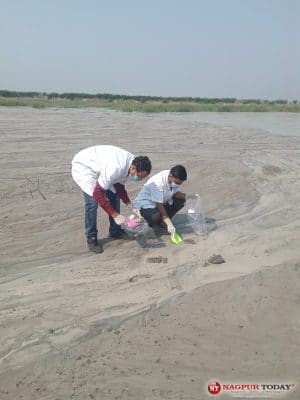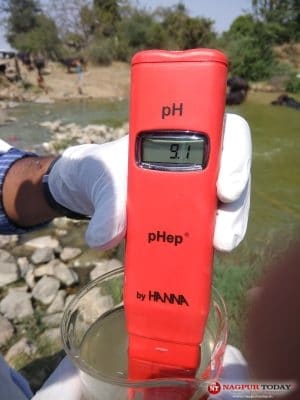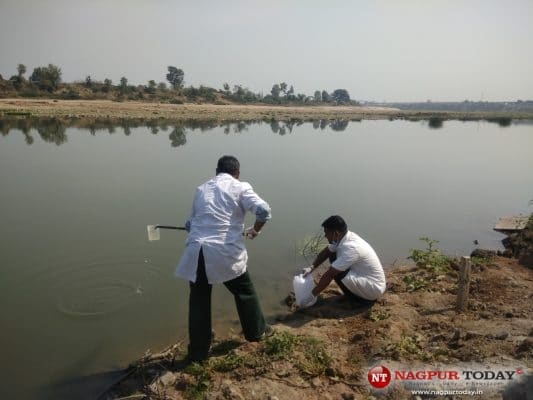In every season, including monsoon, almost all water samples failed to meet the Bureau of Indian Standards drinking water acceptable limits; study recommends immediate stop to alarming pollution
Nagpur: A new study has revealed extensive and rampant pollution in the areas around Maharashtra State Power Generation Company (Mahagenco) 2400 MW Koradi and 1340 MW Khaparkheda thermal power plants.
The study has found surface and ground waters contaminated with toxic metals like mercury, arsenic, aluminium, lithium etc. and has recorded widespread contamination of air, water and soil due to fly ash.
The report of the study, titled “Polluted Power: How Koradi And Khaperkheda Thermal Power Stations Are Impacting The Environment” has called for an immediate halt to the discharge of pollutants from the power plants and ash ponds. The research also strongly suggests that all prior pollution-related harm be cleaned up under the supervision of a commission comprising local community and civil society members, as well as independent experts.
The study has been carried out by Centre for Sustainable Development (CFSD), Nagpur, Manthan Adhyayan Kendra, Pune, and ASAR Social Impact Advisors Pvt. Ltd. with the involvement of the local communities.
“We initiated this study together given the long history of pollution due to these power plants and their related infrastructure like ash ponds and the complete failure of official agencies in addressing the problem,” said Leena Buddhe, Director, CFSD and co-author.
She informed that the concern was that the Ministry of Environment, Forests & Climate Change (MoEF&CC) has given terms of references (ToRs) for the further expansion of Koradi TPS’ two units (660 megawatt). “This is a major concern as it will lead to even more pollution,” said Buddhe.
Shripad Dharmadhikary, Co-author of the Study and Coordinator, Manthan Adhyayan Kendra stated that the study has revealed how badly the water resources of the area have been polluted by the Koradi and Khaparkheda power plants. “Till now, air pollution due to the plants had received some attention, but detailed analysis of water pollution was not available. Our study is probably the first such attempt to comprehensively map out the water contamination due to these power plants,” he said.
“High levels of aluminium, boron, fluoride magnesium and lead in water used for drinking or domestic use has been known to cause serious health hazards like cancer, respiratory, neurological and cardiovascular disorders,” said Dr Sameer Arbat, Interventional Pulmonologist, One Healthcare India.
How was the study conducted:
This study had three components. One was a detailed questionnaire based survey of the villages in the surrounding areas. Second was the collection and testing of water samples from surface and groundwater locations in the area including Kanhan and Kolar rivers, as well as fly ash samples, to be carried out in three seasons of winter, summer and monsoon. Third part was the direct observations by the study team.
Water samples were collected from 25 locations including surface and groundwater (across rivers like Kanhan and Kolar) and treatment facilities. Fly ash samples were collected from 5 locations including ash ponds of the two power plants and a couple of households. Detailed village-level surveys were done for 21 villages, as well with a similar number of individual households and farmers. Information through discussions was also collected from Nagpur city wards that are located towards the power plants.
Findings from the study:
Koradi and Khaparkheda TPS’ as well as their ash ponds are discharging effluents directly into local streams and rivers including the Kolar and Kanhan rivers, and this include fly ash mixed effluents. The study has directly observed and documented six such locations.
Almost every water sample, in every season including monsoon, failed to pass the standards set for drinking water by the Bureau of Indian Standards, the IS 10500: 2012 (acceptable limits) and other relevant standards, with the sole exceptions of samples from Water ATM output (an automatic water dispensation system).
The study found several water samples with toxic elements like mercury, arsenic, lithium, aluminium etc. exceeding the safe limits by 10-15 times. Mercury is among the most toxic substances known to mankind. Arsenic is associated with cancers of liver and bladder.
High levels of turbidity, hardness, alkalinity, and total dissolved solids (TDS) have been discovered in both surface and groundwater sources. Antimony, Aluminium, Arsenic, Boron, Fluoride, Iron, Manganese, Magnesium, Mercury, Molybdenum, Lithium Lead, and Selenium are among the elements found in high amounts.
Many of these pollutants are found in the fly ash produced by the two power plants, including arsenic, cadmium, chromium, lead, manganese, mercury, selenium, cobalt, copper, nickel, zinc, fluoride, and oil and grease. When fly ash dust is breathed, it can immediately enter the lungs, creating problems as particulate matter on one hand and also taking the heavy metals into the lungs on the other; and when fly ash combines with water, these metals can leach into the water.
These contaminated ground and surface waters are being used by local communities extensively, for all purposes including drinking (with and without treatment), other domestic use, bathing, washing clothes, fishing, irrigation and water for cattle. This has serious implications for their well-being as these pollutants are known to have many adverse impacts on human and cattle health.
The questionnaire based survey also revealed that out of 21 villages surveyed, 18 villages are being affected due to fly ash depositing in various parts of the village. This includes water bodies, houses, agricultural fields, open spaces and vehicles.
Airborne fly ash is leading to extensive air pollution. This airborne fly ash is also depositing across a large area on houses, open spaces, water bodies, and agricultural fields. This is fly ash that is blown from the dry areas of ash ponds, as well as other sources such as air emissions from within the plant and power station stacks.
Almost all the farmers in the survey responded that fly ash was depositing on their lands and crops, impacting the growth of their crops, reducing crop yields, impacting cattle and affecting milk production.
Many of the surveyed villages reported health issues like difficulty in breathing, respiratory diseases like bronchitis and asthma, cough and cold, throat infection, irritation in the eyes and eye infections, skin problems, skeletal problems etc. Skeletal problems were also reported in cattle. All of these ailments can be linked to the contaminants that the study identified.
Apart from villages, several areas on the outskirts of Nagpur city were being affected by the deposition of fly ash.
Apart from total failure in controlling the pollution, Mahagenco and the regulatory agencies have shown complete indifference to local people who have been repeatedly raising the issue and petitioning the authorities. Even letters written by elected representatives like the sarpanchs have gone unanswered.
Residents are affected by fly ash and polluted water, which causes respiratory, skin, eye, and gastrointestinal problems. Fly ash has been linked to an increase in asthma cases as well as eye discomfort, watery eyes, dry skin, and itchy skin. Similarly, gastrointestinal illnesses are a common occurrence in this area as a result of contaminated water. What makes these diseases unique is that they affect people of all ages, from children to the elderly.
Dr. Nikhil Bhure, local physician from Khasala
As a result of the spread of fly ash in the air, villagers in this area suffer from respiratory illnesses such as asthma, especially during the summer and winter seasons. During this period, itching of the skin and burning of the eyes can also be an issue. Residents have been dealing with this issue for a long time.
Dr. C P Sharma, local doctor from Khasala
Short-term exposure to antimony in drinking water at extremely high concentrations (more than 30 mg/L) can produce nausea, vomiting, and diarrhoea. Molybdenum concentrations in finished water can reach 200 g/litre in regions near molybdenum mining activities. The findings of a cross-sectional research of 400 people in two towns in a molybdenum-rich area of the former Soviet Union revealed that high molybdenum consumption (10–15 mg/day) was linked to a high incidence (18–31 percent) of gout-like illness. Joint aches in the legs and hands, enlargement of the liver, gastrointestinal, liver, and renal diseases, increased blood levels of molybdenum and uric acid, increased xanthine oxidase activity, reduced blood levels of copper, and increased urine copper were all symptoms of the condition.
Dr Sameer Arbat, Interventional Pulmonologist, One Healthcare India


















